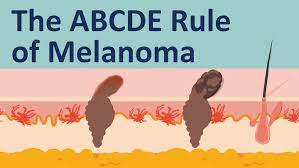What does the mnemonic device ABCDE stand for?
- A- Allergy, bleeding, chemicals, dietary, environment
- B- Allergy, bleeding, cardio, diabetes, endocrine
- C- Allergy, bleeding, cardio, digestive, endocrine
- D- Allergy, bleeding, cortisone, diabetes, emboli
The mnemonic device ABCDE does not stand for any of the options you listed (A, B, C, or D).
It stands for:
- A- Asymmetry
- B- Border
- C- Color
- D- Diameter
- E- Evolving
This mnemonic is used in the medical field to remember the key characteristics to be aware of when examining moles for possible signs of melanoma, the most serious type of skin cancer.
Here's a breakdown of each letter:
A - Asymmetry:
A normal mole is typically symmetrical, meaning if you could draw a line through the middle, both halves would match. Asymmetrical moles, where one half doesn't match the other, are a potential warning sign.
B - Border:
Healthy moles typically have smooth, well-defined borders. Conversely, the borders of cancerous or pre-cancerous lesions may appear blurred, jagged, or notched.
C - Color:
Most benign moles have a uniform color, whether it's brown, tan, or black. However, melanomas often exhibit uneven coloring or multiple shades within the same mole.
D - Diameter:
While not all large moles are problematic, melanomas are typically larger in diameter than the eraser on a pencil (about 6 millimeters or 1/4 inch). However, it's essential to note that melanomas can also be smaller when first detected.
E - Evolving:
Any changes in size, shape, color, or texture of a mole over time should be closely monitored. Evolving moles could be a sign of melanoma and require further evaluation by a healthcare professional.
Remember, the ABCDE rule is a helpful tool to be aware of when examining moles, but it's not a definitive diagnosis tool. If you notice any concerning changes in a mole, it's crucial to consult a doctor or dermatologist for proper evaluation.
